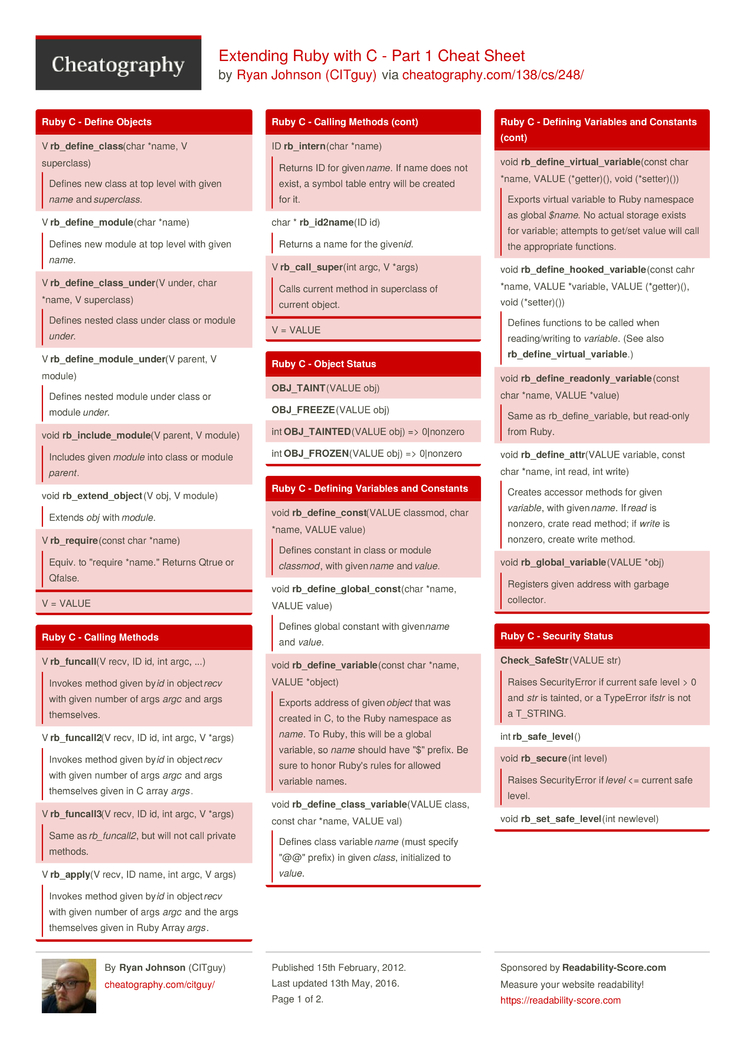Comparing basic object checking methods of ruby and Rails.
Ruby Methods Cheat Sheet 5e
- A cheat sheet or a reference guide for Ruby on Rails which contains the Default directory structure, Methods, Pre-defined variables, Reserved words and Regular expression syntax. Make sure to join our Twitter and subscribed to our RSS feed?
- Using definemethod along with instancevariableset('@#namehere', value) and instancevariableget('@#namehere'), we can elegantly form a number of related methods from a list of names; e.g., recall attraccessor. Whence design patterns becomelibrarymethods! In Ruby, just as methods can be overriden and advised,classesare open: They can be.
# method 1, the simplest and most intuitive way of declaring array! Array = 1, 2, 3 # method 2, using Array object array = Array. New array1 = Array. New (3) # will create array of size 3 array2 = Array. K lite codec mac. New (3, 'ruby') # ^ and will fill array with value-'ruby' # for some dynamic values, you can use below array3 = Array. New (5) index. Strings are objects in Ruby. This means that they have methods. (In fact everything in Ruby is an object.) A method call look like this: 'simon'.upcase returns 'SIMON' A method is a function for a particular type of object. In this case, the thing before the period is the object, in this case a string ('simon'). The method is upcase. Ruby Strings cheat sheet of all shortcuts and commands.
For a novice in ruby and Rails it is not obvious which object checking methods come from where and what methods better to use for what and in which situation. There are many blog posts and StackOverflow questions about this topic (personal I inspired by A concise explanation of nil v. empty v. blank in Ruby on Rails Ask Question). That is why I decide to organize this information for myself in the current blog post, and I would be glad if it will be useful for someone else.
Basic object checking methods
| Methods | |||||||
|---|---|---|---|---|---|---|---|
| Ruby | Rails | ||||||
| Object | String, Array, Hash | Enumerable | Numeric | Object | |||
| if condition !! operator | nil? | empty? | any? | zero? | blank? | present? | |
| nil | false | true | NoMethodError | NoMethodError | NoMethodError | true | false |
| false | false | false | NoMethodError | NoMethodError | NoMethodError | true | false |
| true | true | false | NoMethodError | NoMethodError | NoMethodError | false | true |
| 0 | true | false | NoMethodError | NoMethodError | true | false | true |
| 1 | true | false | NoMethodError | NoMethodError | false | false | true |
| ' | true | false | true | NoMethodError | NoMethodError | true | false |
| ' ' | true | false | false | NoMethodError | NoMethodError | true | false |
| [] | true | false | true | false | NoMethodError | true | false |
| [nil] | true | false | false | false | NoMethodError | false | true |
| {} | true | false | true | false | NoMethodError | true | false |
| {a: nil} | true | false | false | true | NoMethodError | false | true |
Rails helper methods with object checking
presence
Ruby Methods Cheat Sheet
Returns the receiver if it's present otherwise returns nil. object.presence is equivalent to:
try
Invokes the public method whose name goes as first argument just like public_send does, except that if the receiver does not respond to it the call returns nil rather than raising an exception.

try!
Ruby Array Methods Cheat Sheet
Same as try, but raises a NoMethodError exception if the receiver is not nil and does not implement the tried method.
Final thoughts

What app can use to download videos in macbook for free. It is obvious, when working with Rails it is better to use Rails object checking methods. In that case, ruby object checking methods must be used only if you what to emphasize some special meaning of a certain expression.
